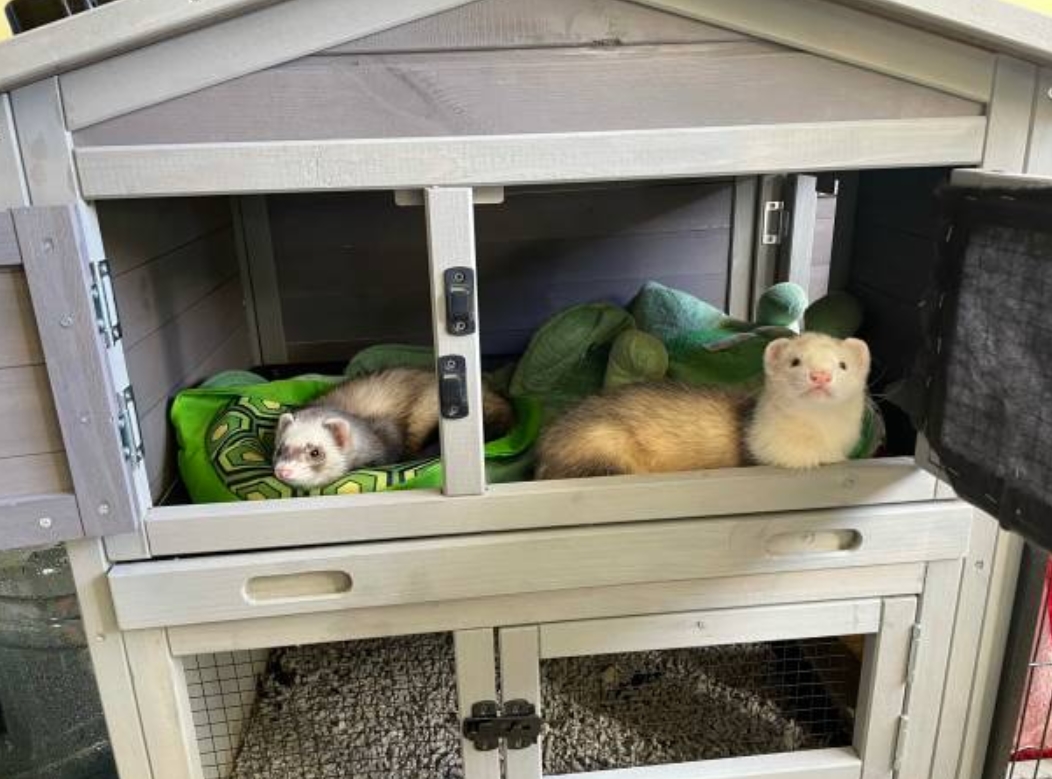Ferrets are cute and playful animals that make great pets for many people. They are small mammals with long, slender bodies and short legs. Ferrets are intelligent and social creatures that enjoy playing with their owners and exploring their surroundings. They can be trained to do tricks and are often described as having a mischievous personalities. Ferrets require regular care, including Ferret Housing, feeding, grooming, and exercise, but with proper attention and care, they can make wonderful pets for individuals and families alike
It is important to provide a safe and comfortable home for your pet ferret because they are living creatures that need proper care and attention. A safe home will prevent your ferret from getting hurt or sick. A comfortable home will make your ferret happy and healthy. Ferrets are active animals that need space to move around and play. They also require specific types of bedding, litter, and food. By providing your ferret with a safe and comfortable home, you are helping to ensure its overall well-being and happiness.
Ferrets as Pets: 101 The Ultimate Guide to Understanding Your Furry Friends
Tip #1: Choose the Right Cage
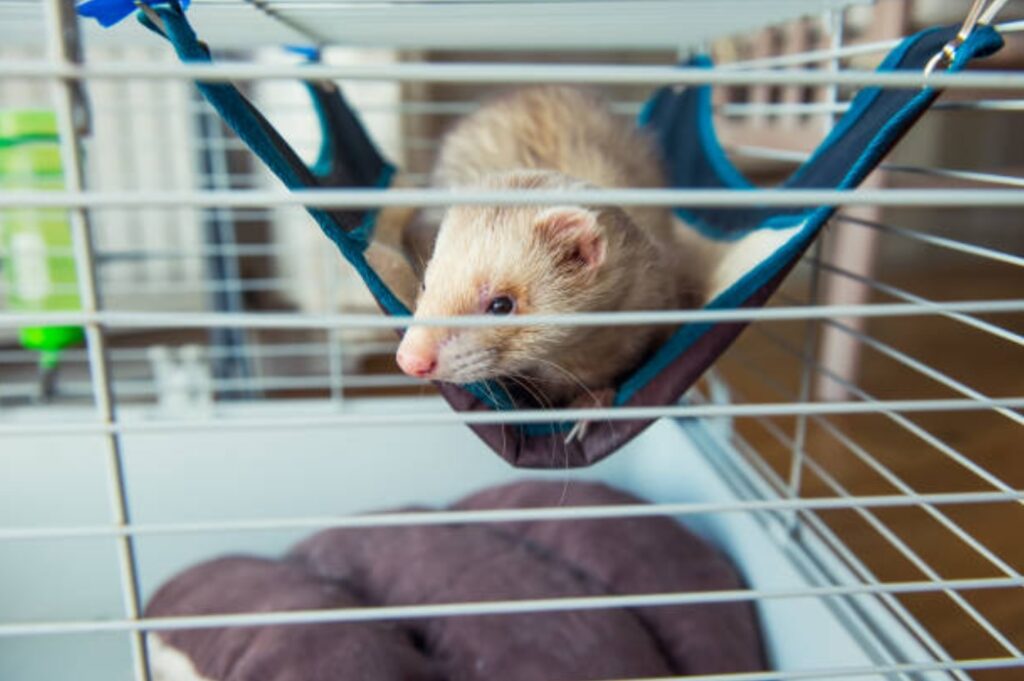
Ferret cage size and design considerations
When choosing a cage for your ferret, size, and design are important considerations. Ferrets need a cage that is large enough for them to move around and play. The cage should be at least 18 inches wide, 18 inches deep, and 30 inches tall for one ferret, and even larger for multiple ferrets.
A multi-level cage with ramps and platforms can provide more space and opportunities for exercise and exploration. The cage should also be made of sturdy materials and have secure doors and latches to prevent escapes. Additionally, the cage should have proper ventilation and be easy to clean and maintain.
Material and construction quality
When choosing a ferret cage, material and construction quality are important factors to consider. Ferrets are active and curious animals that may chew or scratch their cage, so it’s important to choose a cage made of sturdy and durable materials like metal or heavy-duty plastic. The bars of the cage should be close enough together to prevent your ferret from squeezing through or getting its head stuck.
The cage should also be constructed with solid welds and strong connections to prevent any weak spots or gaps. A well-made cage will not only keep your ferret safe but will also last longer and require less maintenance over time.
Features to look for in a ferret cage
There are several features to look for in a ferret cage that can make it more comfortable and enjoyable for your pet. One important feature is multiple levels, which can provide more space and opportunities for climbing and playing. The cage should also have a solid floor or a grate floor that is comfortable for your ferret to walk on. Ferrets like to burrow and hide, so a cage with a hiding spot or a hammock can provide a cozy spot for your pet to rest.
The cage should also have easy access to food and water bowls, as well as a litter box. Lastly, the cage should have wheels or be easy to move, as ferrets should be able to spend time outside of their cage for exercise and playtime.
Tip #2: Set Up the Cage Properly
Cage placement
The placement of your ferret’s cage is also an important consideration. The cage should be placed in a quiet area of your home where your ferret can feel safe and secure. Avoid placing the cage near loud noises or areas where there is a lot of foot traffic. The cage should also be kept away from direct sunlight or drafts, as ferrets are sensitive to temperature changes.
The cage should be placed on a level surface and not on the carpet, as ferrets may try to dig or chew through the carpet. Finally, make sure the cage is positioned in a way that allows for easy cleaning and maintenance.
Bedding materials
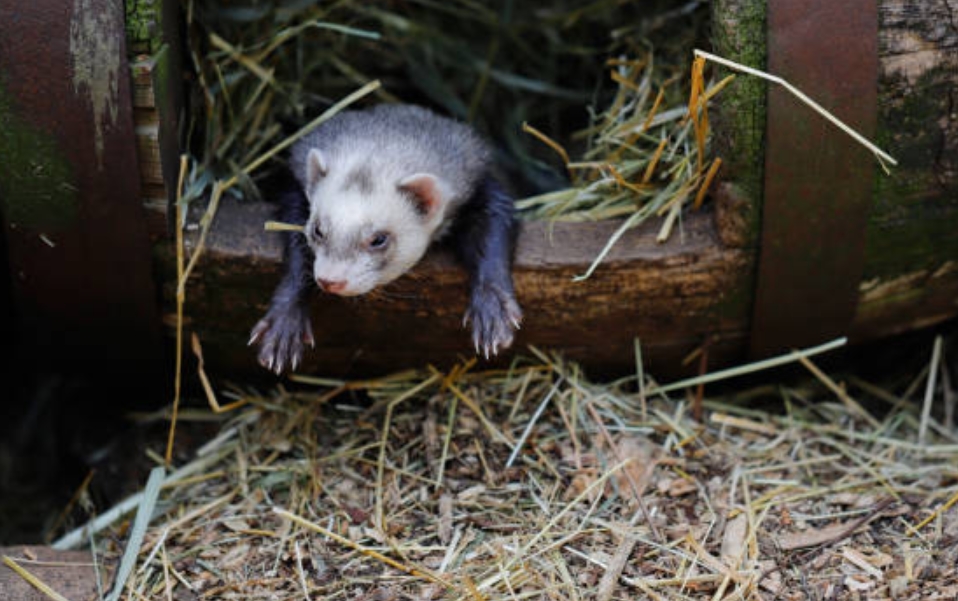
Choosing the right bedding materials is important for your ferret’s comfort and health. Ferrets need bedding that is soft and absorbent, and that won’t harm their respiratory system.
Avoid using cedar or pine shavings, as the dust and oils in these types of wood can be harmful to ferrets. Instead, choose to bed made of paper or recycled materials.
A good option is pelleted paper bedding that is designed for small animals. The bedding should be changed regularly, at least once a week, to keep the cage clean and hygienic. Additionally, adding a small amount of hay or a soft towel can provide your ferret with additional warmth and comfort.
Litter boxes and litter types
Ferrets are naturally litter trained, so providing a litter box in their cage is important. The litter box should be placed in a corner of the cage, away from the food and water bowls. There are several types of litter that are safe for ferrets, including recycled paper pellets, clay, and wood pellets. Avoid using clumping litter, as these can be harmful if ingested.
How to Train a Ferret: Effective Ferrets Training Tips and Tricks
Some ferrets prefer a certain type of litter, so it’s important to experiment and find the one that works best for your pet. The litter box should be cleaned regularly, at least once a day, to keep the cage clean and odor-free. It’s also a good idea to have an extra litter box outside of the cage for when your ferret is out and about.
Food and water dispensers
Providing food and water dispensers in your ferret’s cage is important for their health and well-being. Water should be provided in a bottle or a bowl that is attached to the side of the cage. A water bottle is a good option as it keeps the water clean and prevents spills. The water should be changed daily and the bottle or bowl should be cleaned regularly.
Ferrets have high metabolisms and need to eat frequently, so it’s important to provide food in their cage at all times. A bowl or dispenser that can hold dry ferret food is a good option. Ferrets should be fed high-quality ferret food that is high in protein and fat.
The food should be changed daily and the bowl or dispenser should be cleaned regularly to prevent bacteria growth. Additionally, it’s important to monitor your ferret’s food and water intake to ensure they are getting enough and to prevent overeating.
Tip #3: Provide Enrichment and Toys
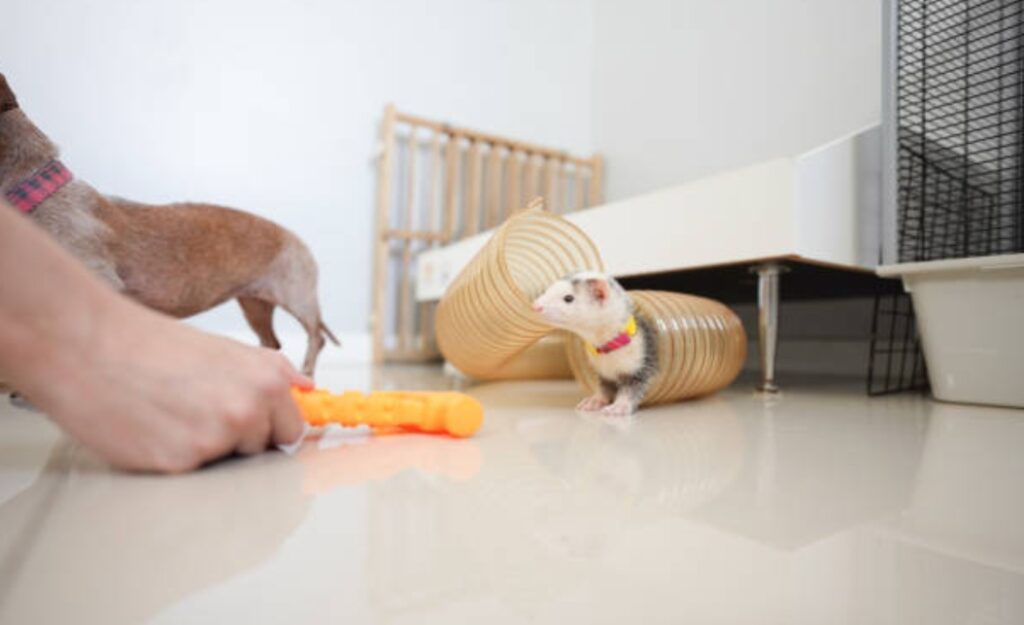
Ferret playtime and exercise needs
Ferrets are active and playful animals that need regular exercise and playtime outside of their cage. It’s important to provide them with a safe and secure area to play, such as a ferret-proofed room or playpen. Ferrets love to explore and climb, so providing them with toys and tunnels can keep them entertained and provide exercise. It’s also important to spend time interacting with your ferret and playing with them. This can help strengthen the bond between you and your pet and keep them mentally stimulated.
Ferrets need at least 2-3 hours of playtime and exercise outside of their cage each day. It’s important to supervise your ferret during playtime to ensure their safety and to prevent them from getting into anything dangerous. Regular playtime and exercise can help prevent health problems and keep your ferret happy and healthy.
Safe toys and play objects for ferrets
Choosing safe toys and play objects for your ferret is important to prevent injury and keep them entertained. Ferrets love toys that they can climb, tunnel through, and interact with. Good options include plastic tubes, balls, stuffed animals, and chew toys.
Avoid toys with small parts that your ferret can swallow or choke on, as well as toys made of rubber or latex, which can be harmful if ingested.
It’s also important to rotate your ferret’s toys regularly to keep them interested and prevent boredom. Additionally, providing your ferret with cardboard boxes or paper bags to play with can provide them with hours of entertainment. Just make sure to remove any plastic or staples from the boxes or bags before giving them to your pet.
How to rotate and introduce new toys
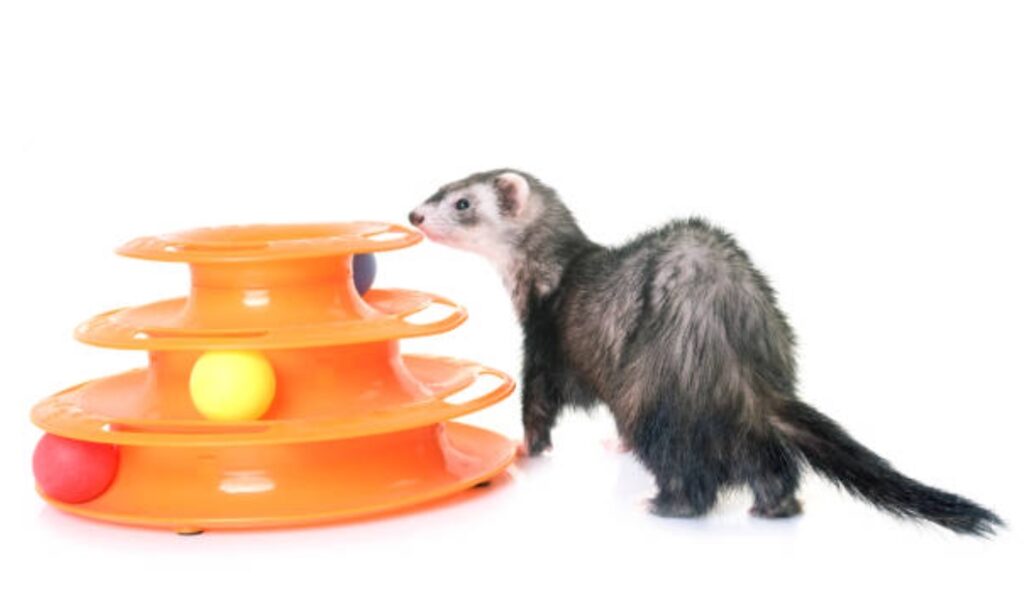
Rotating your ferret’s toys and introducing new ones can help keep them mentally stimulated and prevent boredom. To rotate toys, simply remove some of the toys in their play area and replace them with new ones. It’s important to do this on a regular basis to prevent your ferret from becoming bored with its toys.
When introducing new toys, it’s best to do so gradually. Start by placing the new toy in their play area and observe how your ferret reacts to it. If they show interest in the toy, you can encourage them to play with it by interacting with them and the toy. If they don’t show interest, try placing the toy in a different location or adding a treat to it to make it more appealing. It’s important to always supervise your ferret when they are playing with new toys to ensure their safety and to prevent them from swallowing or choking on any parts.
Tip #4: Ferret-Proof Your Home
Ferret-proofing essentials
Ferret-proofing your home is essential to keep your pet safe and prevent them from getting into anything dangerous. Here are some ferret-proofing essentials:
- Block off any small spaces where your ferret could get stuck or escape, such as gaps under doors or behind appliances.
- Cover any electrical cords or wires with cord covers or tubing to prevent your ferret from chewing on them and getting electrocuted.
- Keep any toxic substances, such as cleaning products or plants, out of reach and locked away.
- Secure any cabinets or drawers that your ferret could open.
- Remove any fragile or breakable items from your ferret’s play area to prevent accidents.
- Cover any sharp edges or corners with protective padding.
- Ensure that windows and doors are securely closed and have screens to prevent your ferret from escaping.
- Keep any other pets, such as cats or dogs, separated from your ferret to prevent injury or aggression.
By taking these steps to ferret-proof your home, you can create a safe and secure environment for your pet to play and explore.
Common household hazards and how to avoid them
There are many common household hazards that can pose a danger to your ferret. Here are some of them and how to avoid them:
- Toxic substances:
- Keep cleaning products, chemicals, and medications out of reach and locked away. Store them in cabinets or drawers that your ferret can’t open.
- Electrical cords and wires:
- Cover cords and wires with cord covers or tubing to prevent your ferret from chewing on them and getting electrocuted.
- Sharp objects:
- Keep any sharp objects, such as knives or scissors, out of reach.
- Appliances:
- Keep your ferret away from appliances, such as stoves or refrigerators, to prevent them from getting trapped or injured.
- Small objects:
- Keep small objects, such as coins or buttons, out of reach to prevent your ferret from swallowing them and choking.
- Plants:
- Some plants can be toxic to ferrets, so make sure to research any plants in your home and remove any that could be harmful.
- Windows and doors:
- Make sure that windows and doors are securely closed and have screens to prevent your ferret from escaping.
- Other pets:
- Keep your ferret away from other pets, such as cats or dogs, to prevent injury or aggression.
By being aware of these common household hazards and taking steps to prevent them, you can help ensure the safety and well-being of your pet ferret.
Tips for keeping ferrets safe and contained when outside the cage
When letting your ferret out of its cage, it’s important to take precautions to keep them safe and contained. Here are some tips to help:
- Supervise your ferret at all times:
- Don’t leave your ferret alone or unsupervised when outside its cage.
- Ferret-proof the room:
- Make sure the room is free of any potential hazards, such as sharp objects, electrical cords, or toxic substances.
- Use baby gates:
- Use baby gates to block off any areas that your ferret shouldn’t go into.
- Provide a playpen:
- Set up a playpen for your ferret to play in. Make sure it’s large enough for them to move around and has plenty of toys and hiding spots.
- Use a harness and leash:
- If you want to take your ferret outside, use a harness and leash to keep them safe and contained.
- Train your ferret:
- Train your ferret to come when called and to stay in certain areas of the room.
- Be prepared for accidents:
- Have paper towels and cleaning supplies on hand in case your ferret has an accident outside the cage.
By following these tips, you can help ensure that your ferret stays safe and contained when outside their cage, while still providing them with plenty of opportunities for play and exploration.
Tip #5: Establish a Feeding Routine
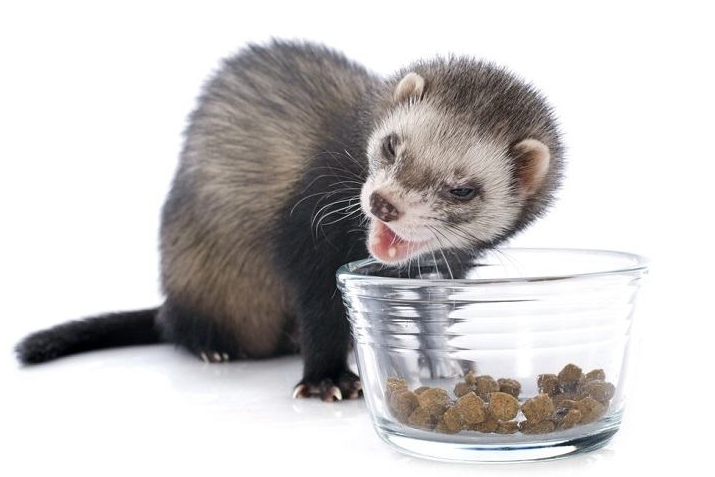
Feeding your ferret a healthy and balanced diet is essential for their overall health and well-being. Here are some tips on establishing a feeding routine for your ferret:
Ferret dietary needs and feeding schedule
Ferrets are obligate carnivores, which means they require a diet that is high in animal protein and fat. It’s important to feed your ferret high-quality commercial ferret food that meets its nutritional needs. Ferrets should be fed small meals throughout the day, as they have a fast metabolism and can develop hypoglycemia (low blood sugar) if they go too long without eating. Generally, ferrets should be fed 2-4 small meals per day.
Recommended types of food for ferrets
When selecting a commercial ferret food, look for one that has a high percentage of animal protein (at least 30%) and fat (at least 18%). Avoid foods that contain high levels of carbohydrates, as ferrets have a difficult time digesting them. You can also supplement your ferret’s diet with raw or cooked meat (such as chicken, turkey, or beef) and small amounts of fresh fruits and vegetables.
What Do Ferrets Eat: Ferret’s Healthy Diet
How to monitor your ferret’s food and water intake
Make sure your ferret always has access to fresh, clean water. Monitor their food intake to make sure they’re eating enough and not losing weight. You can also weigh your ferret regularly to track their weight and make sure they’re maintaining a healthy body condition. If you notice any changes in your ferret’s appetite or weight, contact your veterinarian.
By establishing a feeding routine and providing your ferret with a healthy and balanced diet, you can help ensure that they stay healthy and happy for years to come.
Tip #6: Maintain Proper Hygiene
Proper grooming and cage cleaning are important for keeping your ferret healthy and comfortable. Here are some tips on grooming, cage cleaning, and odor control for your ferret’s living space:
Ferret grooming needs
Ferrets are naturally clean animals and do not require frequent baths. However, they do need regular nail trimming, ear cleaning, and teeth brushing. You can use a soft-bristled toothbrush and ferret-safe toothpaste to brush your ferret’s teeth. For nail trimming and ear cleaning, it’s best to have your veterinarian show you the proper technique.
Cage cleaning and maintenance
Ferret cages should be cleaned regularly to prevent the buildup of odor and bacteria. Remove any soiled bedding, litter, and food debris on a daily basis. The entire cage should be thoroughly cleaned and disinfected once a week. Use a pet-safe cleaner and rinse the cage thoroughly with water before allowing your ferret back in.
Tips for controlling odor in the ferret’s living space
Ferrets have a musky odor that can be managed with regular cage cleaning and maintenance. Use bedding materials that are designed to control odor, such as paper-based or pellet-based bedding. You can also use an air purifier or air freshener specifically designed for pet odors. Avoid using harsh chemicals or strong-smelling cleaning products, as they can be irritating to your ferret’s sensitive respiratory system.
By following these tips for grooming, cage cleaning, and odor control, you can help ensure that your ferret stays healthy and comfortable in their living space.
Tip #7: Monitor Your Ferret’s Health
It’s important to monitor your ferret’s health closely and be aware of any signs of illness or distress. Here are some common signs of health problems in ferrets, as well as tips for preventive care and early intervention:
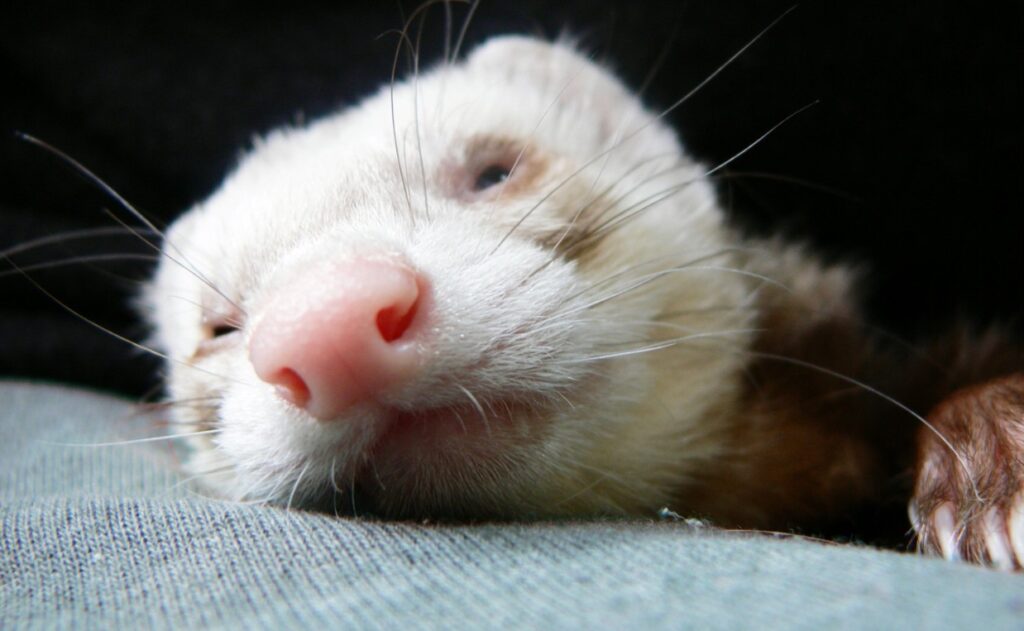
Signs of illness or distress in ferrets
- Loss of appetite or weight loss
- Lethargy or weakness
- Difficulty breathing or coughing
- Diarrhea or loose stools
- Vomiting
- Scratching or biting at the skin
- Swelling or discharge from eyes, nose, or ears
- Changes in behavior, such as aggression or lethargy
Regular vet check-ups and preventive care
Ferrets should have annual check-ups with a veterinarian who specializes in exotic animals. During these visits, your ferret will receive a physical exam, vaccinations, and parasite prevention. Regular check-ups can help catch potential health issues early and prevent more serious problems down the line.
How to spot and address potential health issues early on
Be observant of your ferret’s behavior and appearance on a daily basis. Check for any changes in appetite, weight, or activity level. Keep an eye out for any of the signs of illness or distress listed above. If you notice any concerning symptoms, make an appointment with your vet as soon as possible. Early intervention can often make a big difference in treating health issues and preventing further complications.
By staying alert to your ferret’s health and getting regular check-ups with a veterinarian, you can help keep your pet healthy and happy for years to come. Ferret Housing: most relative content around the net vcahospitals.com, merckvetmanual.com, rspca.org.uk, burgesspetcare.com.
Conclusion of Ferret Housing
In conclusion, ferret housing is an important aspect of providing a safe and comfortable environment for your pet. By following these seven tips, you can help ensure that your ferret stays healthy, happy, and safe:
- Choose the right size and design for the cage
- Consider material and construction quality
- Look for important features in a ferret cage
- Properly place the cage in your home
- Establish a feeding routine for your ferret
- Keep your ferret clean and odor-free with regular grooming and cage maintenance
- Ferret-proof your home and avoid common household hazards
By prioritizing your ferret’s well-being and following these tips, you can provide a loving home for your furry friend. Remember, a healthy and happy ferret is a wonderful addition to any family.
We hope you found this guide on ferret housing informative and helpful! Do you have any additional tips or experiences to share? We’d love to hear from you in the comments section below. Your insights and feedback can help other readers create an even safer and more comfortable home for their furry friends. Let’s build a community of ferret lovers who prioritize their pets’ well-being together!
